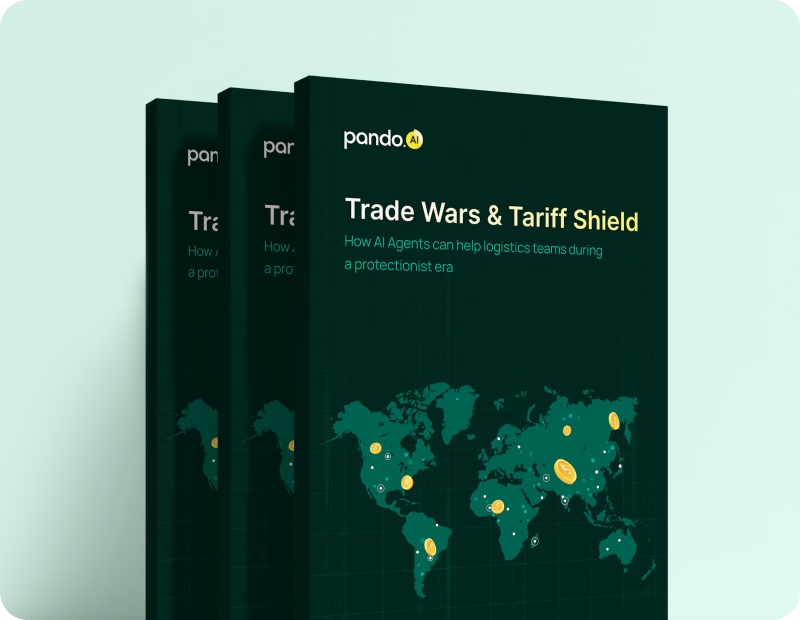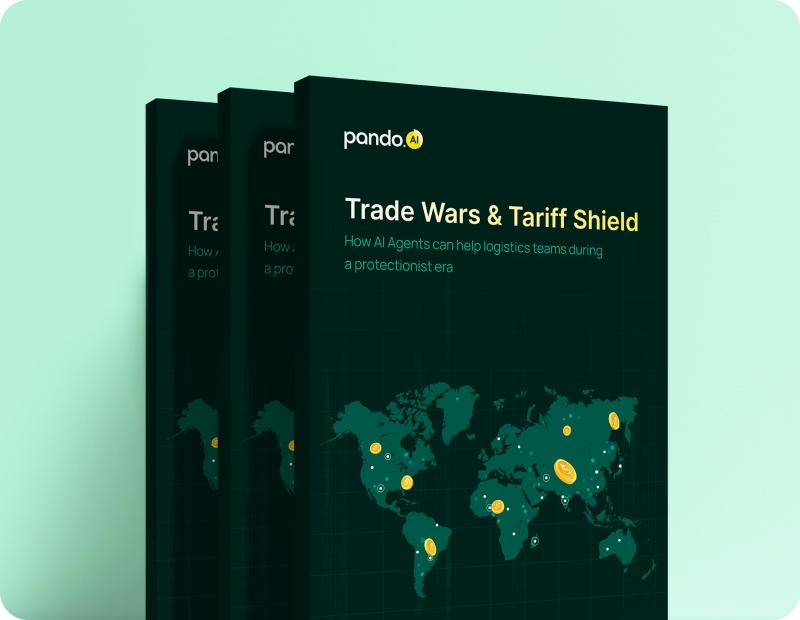-
Products Products
- Industry
- Initiatives
- Resources
- Company
- Book a demo

Before you go: Logistics leaders just dropped the truth on AI
The State of AI in Logistics 2025 is here — no hype, just real conversations and raw insights.
Ship it green – Bringing a sustainability lens to freight sourcing
Find out how including sustainability strategies in freight and transportation sourcing can help you contribute more to a greener planet.
Published on May 30, 2024 • 9 mins read
Prakash Ramnath

Find out how including sustainability strategies in freight and transportation sourcing can help you contribute more to a greener planet.
Did you know the logistics and transport sector generates just over a third of global carbon dioxide (CO2) emissions? When you think about sustainability in logistics, you're focusing on the art of balancing economic, social, and environmental factors to meet today's needs without compromising future generations. While we focus on sustainability across supply chain operations, it is rarely applied in the context of freight sourcing and transportation procurement. However, this is changing with the growing awareness of how you can apply the tenets of sustainability to freight sourcing and contribute to reduced emissions.
There is growing regulatory compliance around mandatory sustainability reporting globally. Scope 1 and 2 emissions are direct, and Scope 3 emissions are indirect (arising from the organization's value chain). All emissions through transportation would be considered under scope 3 emissions and this contributes to more than 70% of emissions on average from an organization perspective. For example, Amazon has committed to achieving net-zero carbon emissions by 2040, aligning with regulatory requirements and setting a benchmark for the industry.
Sustainability is an organization-wide strategy and its impact through supply chain and logistics processes can contribute significantly to a greener planet. Freight sourcing and procurement sets the foundation for the logistics process and has ripple effects across midstream and downstream logistics. By prioritizing sustainability at this stage, you can establish the foundation to execute your long-term strategy.
Why should you do sustainable freight sourcing?
Imagine a supply chain that operates like a well-oiled machine: costs are controlled, shipments arrive on time, and your business seamlessly adapts to market demands. Achieving this level of efficiency isn't a distant dream—it's possible through sustainable freight sourcing. By integrating sustainability into your freight procurement strategy, you can optimize operations, reduce environmental impact, and meet regulatory requirements while enhancing brand reputation and customer loyalty. Let’s explore why sustainable freight sourcing should be at the top of your logistics strategy and how it can transform your operations.
Rising regulatory compliance: As governments and international bodies introduce stricter regulations on environmental and social practices, sustainable freight sourcing ensures compliance, helping businesses avoid legal risks and potential fines. By adhering to these standards across scope 3 emissions, companies can navigate global trade more effectively. For instance, the European Union has enacted the Corporate Sustainability Reporting Directive that mandates Scope 3 disclosure in phases for organizations. Recently, the state of California also passed the climate disclosure bill that covers scope 3 emissions that could impact more than 10000+ public and private companies. Hence, most organizations are evolving a strategy to set specific target on scope 3 emissions and aligning organization leadership to measure and progress on their commitments.
Enhance supply chain resilience: Prioritizing sustainable carriers helps organizations to diversify their carrier pool and helps shippers to forge long term partnerships given the transparency around carbon emission reporting and ethical labor practices. Another approach organizations have is building a collaborative sourcing strategy with their carriers to ensure trucks are loaded both ways to reduce empty miles opening alternative routing strategies in the event of disruption. For e.g. IKEA focuses on sustainable packaging and flat-pack furniture designs to minimize transportation space required. They also invest in intermodal transportation, combining rail and sea freight for long distances with built-in redundancy. Similarly, DHL utilizes biofuels and electric vehicles for deliveries, diversifying their transportation methods and potentially improving resilience.
Fostering an equitable supply chain: Sustainable freight sourcing drives sustainability audits on suppliers, which not only measure carriers' environmental impact but also assess their labor practices and community impact. By ensuring that logistics partners adhere to ethical standards, businesses can address issues like workers' rights and community relations, fostering a more equitable supply chain through a supplier code of conduct. This is particularly important because the logistics and transportation industry faces labor shortages due to challenging working conditions. For instance, long-haul truck drivers grapple with long hours, irregular schedules, and time away from home, often for lower wages compared to other industries. Similarly, warehouse worker jobs can be physically demanding, with long hours and potentially unsafe environments, leading to high turnover.
Improve cost efficiency: While there may be upfront costs associated with sustainable freight practices, they often lead to long-term savings. Efficient routing, fuel optimization, and reduced waste can lower operational costs. Additionally, sustainable practices can mitigate risks associated with supply chain disruptions, potentially saving significant costs related to delays and losses.
Sustainability begins at the source
Sustainability in freight procurement and sourcing involves making conscious decisions to reduce the environmental impact of transporting goods. This encompasses strategies to ensure lower GHG emissions, optimize resource use, and minimize waste, while enhancing business efficiency.
Here are key strategies to help you include sustainability within freight sourcing:
1. Conduct sustainability audits of vendors and carriers
Perform regular sustainability audits of your vendors and carriers to ensure they adhere to environmental standards and practices. Assess their use of eco-friendly materials, energy efficiency, waste management practices, and overall commitment to sustainability. Partnering with suppliers and carriers who prioritize sustainability helps create a greener supply chain.
2. Adopt electric vehicles (EV) and alternative fuels
Investing in a fleet of electric vehicles (EVs) or vehicles powered by alternative fuels such as hydrogen can drastically reduce emissions and dependence on fossil fuels. Partnering with carriers who use EVs or hydrogen-powered trucks supports a cleaner and more sustainable supply chain.
3. Leverage multimodal transportation
Utilize a combination of rail, road, and ocean transport to move freight. Rail transport is typically more fuel-efficient and generates fewer emissions than road transport. Integrating these modes can significantly reduce the environmental impact of long-haul shipments.
4. Optimize route planning and reduce empty miles
Efficient route planning minimizes fuel consumption and emissions. Transportation Management software can help you optimize delivery routes to reduce travel distance, avoid traffic congestion, and consolidate shipments. Implement backhaul planning to ensure vehicles are not returning empty after deliveries, reducing empty miles and enhancing fuel efficiency.
5. Partner with sustainable carriers
Work with carriers who prioritize sustainability. Ensure they follow eco-friendly practices, such as using energy-efficient fleets, reducing waste, and employing green technologies in their operations.
6. Encourage reverse logistics
Develop a robust reverse logistics system for returns, recycling, and disposal. Efficient reverse logistics reduce the environmental impact associated with the disposal of goods and materials. Factoring this in your freight sourcing strategy helps you to contribute holistically to your sustainability agenda.
7. Implement carbon offsetting programs
For emissions that cannot be eliminated, carbon offsetting programs provide a way to compensate. Invest in renewable energy projects, reforestation, or other initiatives that help neutralize your carbon footprint.
How can TMS help you in sustainable freight sourcing?
Sustainable freight sourcing has emerged as a significant lever for companies aiming to reduce their environmental footprint while maintaining operational efficiency. This shift is underscored by findings from the World Economic Forum, which suggest that optimizing logistics and freight transportation could potentially reduce global carbon dioxide emissions by 1.6 gigatons annually by 2030. A Transportation Management System (TMS) plays a crucial role in this endeavor, offering a suite of tools and capabilities designed to optimize freight sourcing and significantly reduce environmental impact.
Here's how TMS can help:
- Emission analytics - A TMS equipped with emission analytics can monitor and report the carbon footprint of your transportation activities. By analyzing data on fuel consumption, route efficiency, and vehicle performance by carrier or lane, you can implement strategies to reduce emissions and meet sustainability targets. This helps you track progress and make data-driven decisions to lower your environmental impact. To gain more insights and practical tips on measuring and improving sustainability within your supply chain, check out our recent blog on Measuring Sustainability for a Responsible Supply Chain.
- Optimizing carrier selection - A TMS allows you to evaluate and compare multiple carriers based on various criteria, including their sustainability practices. This helps you choose carriers that not only offer cost-efficiency and reliable service but also align with your sustainability goals, such as using energy-efficient vehicles or adhering to green practices. For more detailed information on optimizing your freight procurement process, including practical use cases, check out our recent blog on the Top 5 Use Cases for Autonomous Freight Procurement. This blog provides valuable insights into leveraging technology for more efficient and sustainable freight operations.
- Leveraging Internet of Things (IoT) - Integrating IoT devices with your TMS provides real-time data on vehicle conditions, shipment status, and environmental factors. IoT enhances visibility and control over the entire transportation process, allowing for proactive management and improved decision-making. This can translate to faster response in case of disruptions with dynamic re-routing decisions to reduce wasted miles or fuel consumption.
- Enabling backhaul optimization - A TMS can help identify opportunities for backhauling, where trucks that would otherwise return empty are filled with goods. This reduces empty miles, improves fuel efficiency, and maximizes the use of transportation assets. Backhaul optimization is a key strategy for minimizing waste and enhancing sustainability.
- Supporting multimodal transportation - A TMS facilitates the integration of different transportation modes—such as road, rail, and ocean—into your logistics network. By enabling the use of more fuel-efficient modes like rail transport, a TMS helps reduce the overall environmental impact of your freight operations. Multimodal transportation also allows for flexibility and optimization of shipments based on sustainability criteria in addition to other levers. Check out our blog on Unveiling the Most Sustainable Way to Transport Your Freight for more insights into identifying the most sustainable methods for freight transport.
Don't just deliver, deliver sustainably
As a leader in logistics, you have the power to make a difference and contribute to addressing climate change. Every choice you make has the potential to ripple across the industry, shaping a greener future.
Innovations are transforming logistics sustainability. AI-driven route optimization reduces fuel consumption, while blockchain ensures supply chain transparency. Electric and hydrogen vehicles are redefining transportation, and biodegradable packaging materials are cutting waste.
By embracing these trends, you don't just meet sustainability goals – you also future-proof your operations and contribute to a greener planet. Deliver sustainably and lead the way to a better tomorrow.
Subscribe to Pando blog and Crossroads newsletter now!
Stay up to date with the latest logistics, transportation, and supply chain tips and news.
Subscribe Here!

Related blogs
Creating a sustainable transport planning: A comprehensive guide for logistics planners












